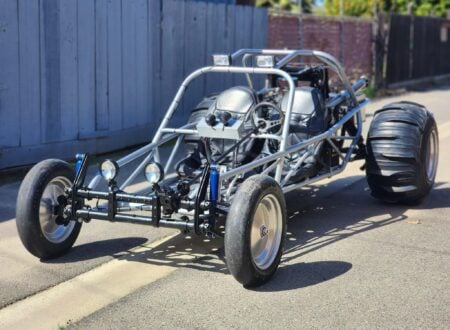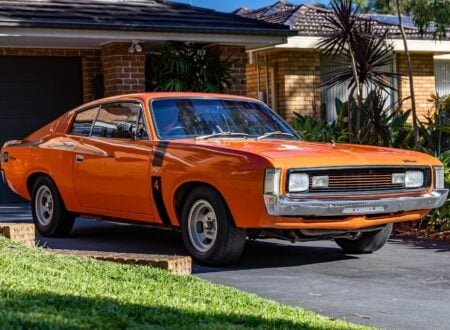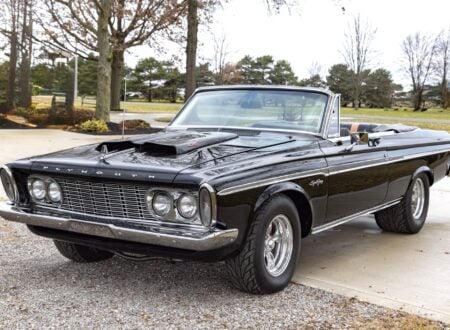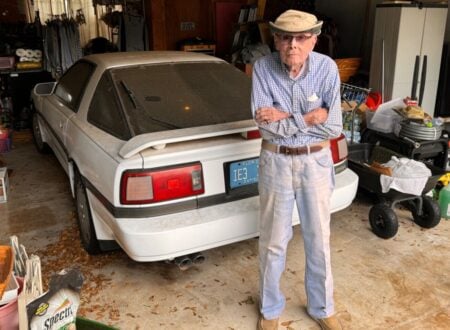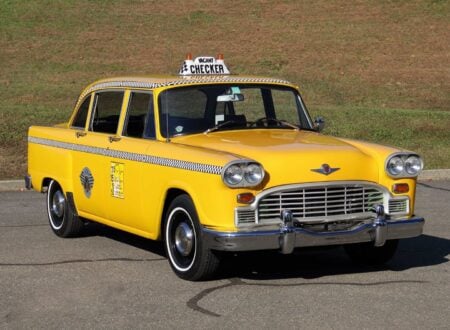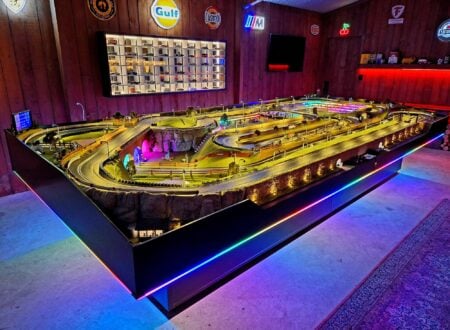The Porsche 944 is one of the most underrated sports cars of its age, with impeccable styling, near perfect weight distribution, a reliable drivetrain, seating for four, ample trunk space, and of course, its wonderful driving characteristics.
Today the 944 is one of the best value ’80s-era sports cars money can buy, and a well-chosen example will give it owner years of driving entertainment – whether it’s a 944 Turbo or the more humble (but still excellent) naturally-aspirated 2.5 litre.
In this Porsche 944 Brief History we’re going to show you everything you need to know about the car – whether you’re looking to buy one for yourself or whether you’re just curious about it and want to learn more.
Fast Facts – Porsche 944
✱ The Porsche 944 was introduced in 1982 and sold until 1991.The model is a 2+2 GT car with ample luggage space, good performance, and a luxurious interior.
✱ The model was based on the Porsche 924, with more aggressive wheel arches, engine options, and performance.
✱ Today the Porsche 944 offers one of the most affordable Porsche ownership experiences, with values ranging from below $10,000 all the way up to over $20,000 to $30,000 for a 944 Turbo.
✱ The 944 has some of the best handling of any sports car of its age thanks to its 50/50 weight distribution and Porsche designed suspension.
In the Beginning was a Porsche with an Audi Engine
The immediate predecessor of the Porsche 944 was the Porsche 924 – a more affordable Porsche than the venerable 911 that sold well and helped keep Porsche in business throughout the 1970s and beyond.
To understand the genesis of the Porsche 924 with its modified Audi engine we need to look at the inter-company dynamics that brought this about: because the car that was to become the “Porsche” 924 and thus the later 944 was not originally intended to be a Porsche at all, it was intended to be a Volkswagen.
During the early 1970’s this new model was given the designation Project EX-425 and it was intended to become Volkswagen’s halo sports car. Porsche were given the brief to design and create it and included in that brief was the requirement that this new sports car must use an existing Volkswagen/Audi inline four cylinder water-cooled engine.
Given that Japanese companies were creating halo sports cars to promote their brands, Toyota’s 2000GT, the Nissan Datsun 240Z, and the Mazda Cosmo, we can understand the desire by Volkswagen/Audi to have such a car of their own.
Although Volkswagen/Audi were moving in the direction of transverse mounted front engine with front wheel drive in many of their production cars the engineers at Porsche knew that would be an unacceptable layout for a sports car.
Settling on a longitudinal front engine with a combined gearbox and differential transaxle at the rear gave this new car a very favorable 48/52 front to rear weight distribution: which, combined with its fully independent Porsche suspension, created a sports car that any knowledgeable enthusiast would appreciate, and it also created a car with the potential to happily handle a lot more engine power than was initially going to get installed in it.
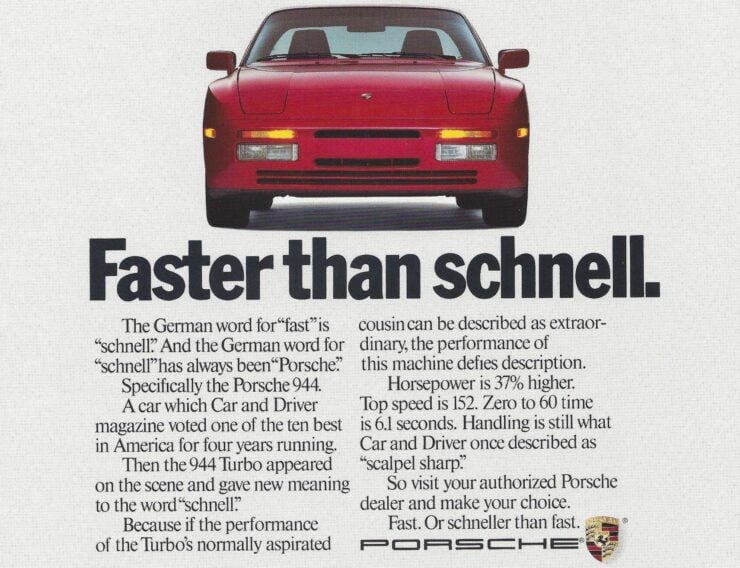
As it turned out politics emerged to dissuade Volkswagen/Audi from continuing the project and producing the Project EX-425, a car that could very well have fundamentally changed the public perception of VW.
As Volkswagen decided to abandon Project EX-425 so Porsche decided to buy the design back from them and use it to create an entry level Porsche to replace the Porsche 914 and 912. But as Porsche had done their design using the Volkswagen/Audi four cylinder engine the Porsche 924 went on sale in 1976 with that power-plant. It sold well regardless managing to sell around 150,000 cars in its 1976-1988 production life.
Give an Apprentice a Hacksaw and Cut the V8 in Half
With the Porsche 924 bringing in a healthy supply of nice crisp banknotes into the Porsche coffers, and with the principal criticism of it being the fact that it was a Porsche with an Audi engine, the obvious thing to do was to take the rather under-powered Audi engine out and drop a nice gutsy Porsche engine in. There was just one tiny little snag, Porsche didn’t have a suitable inline four cylinder to drop into it.
What do you do when you need a four cylinder engine but you only have a V8? The answer was simple, cut the V8 in half and create a suitable four with it.
It wasn’t quite achieved by handing an apprentice a hacksaw and telling him to get sawing but the process of getting the Porsche 944 engine traces back to an initial desire by Porsche to use an Audi five cylinder engine and join two together to create a V10 for their Porsche 928 sports car. However Porsche management decided not to use a base engine from Volkswagen/Audi but instead took on the job of creating their own 5.0 liter V8.
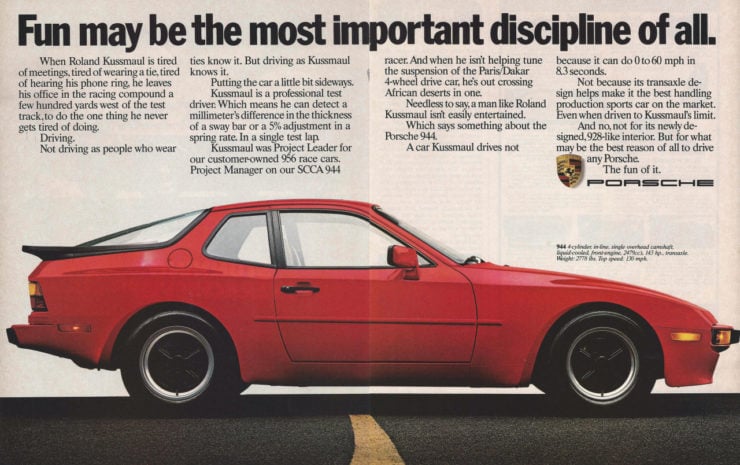
This was to be a completely new design from Porsche, their previous models having been based on Dr. Porsche’s Volkswagen architecture to a greater or lesser extent. It was in part motivated by the thought that the US government was considering outlawing rear engine cars in the wake of Ralph Nadar’s “Unsafe at Any Speed”.
That book had done much damage to the Chevrolet Corvair and by association all rear engine cars despite the fact that the NHSTA study of 1972 had debunked Nadar’s claims. But this was part of the motivation behind Porsche working on creating a front engine sports car and a nice V8 engine that Americans would love.
That new V8 was all alloy and had thick cylinder barrels in part to take advantage of aluminum’s excellent heat dissipating qualities. This engine was created to optimize efficient air flow under a low hood/bonnet line. In its final iteration the engine was a 4.5 liter SOHC double-valve (i.e. 4 valves per cylinder) producing between 219hp and 240hp. This then was the V8 origin of the four cylinder engine Porsche decided to use to create their new four cylinder for the 944.
A Porsche with a Porsche Engine – the Porsche 944
Porsche decided to debut the new 944, which was the replacement for the 924, at the 24 Hours Le Mans race of 1981. This car was fitted with the new 2.5 liter four cylinder engine derived from the alloy V8. There were however many changes made in the transition from half V8 to new inline 4 cylinder.
The four cylinder engine had been fitted with dual counter-rotating balance shafts after the original 1904 design by British engineer Frederick Lanchester and improved upon by Japanese car maker Mitsubishi. The reason for the counter-rotating balance shafts was to balance out the naturally unbalanced secondary forces inherent in an inline four cylinder.
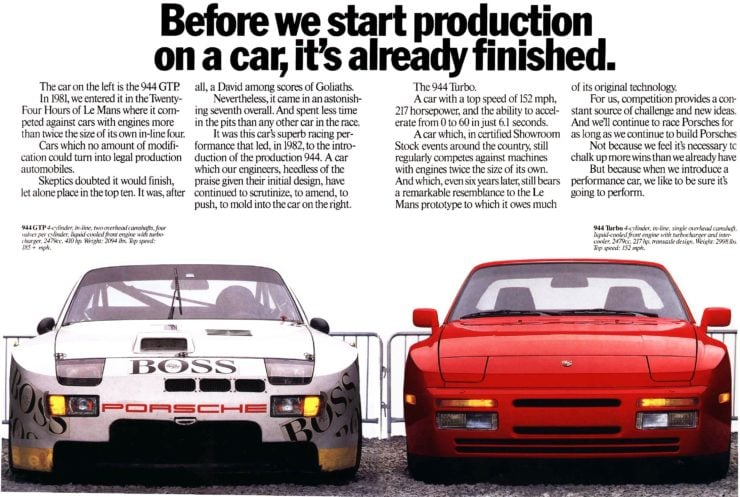
Having been created by halving a V8 the new four cylinder was slanted over at 45 degrees to the right and fitted with a KKK supercharger delivering a rather significant 15.5 psi of boost.
The engine was also fitted with the new Motronic engine management system which was used to intelligently control ignition timing, boost pressure, and the fuel injection system. This race tuned engine churned out an impressive 414 hp @ 6,800 rpm, which was near double the power of the US market version of its parent V8 engine.
The Le Mans race car performed superbly taking seventh place overall behind the purpose built Porsche 936 that won the race. Two elements that helped the racing 944 be so successful were its fuel economy, which enabled it to only make 21 fuel pit stops in the 24 hours, and its reliability.
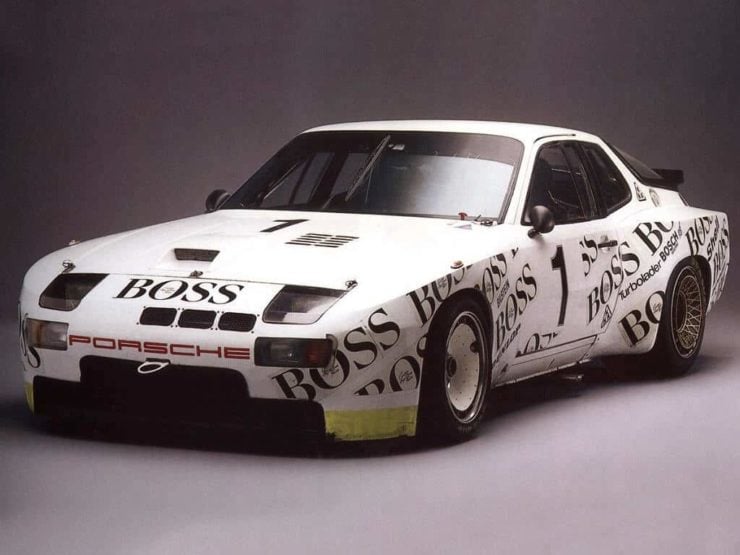
The Porsche 944 (1982-1989)
The Porsche 944 made her debut in 1982 fitted with the 2.5 liter Porsche slant four engine producing 163hp for Europe market cars, and 143hp for US cars (which would be increased to 147hp from 1985-1987).
Although it was basically a 924 with a different engine, body styling and trim, the 944 looked to be a much more businesslike machine: while the 924 looked like a sports car that mild mannered Dr. Jekyll would drive the 944 looked a bit more like a Mr. Hydemobile.
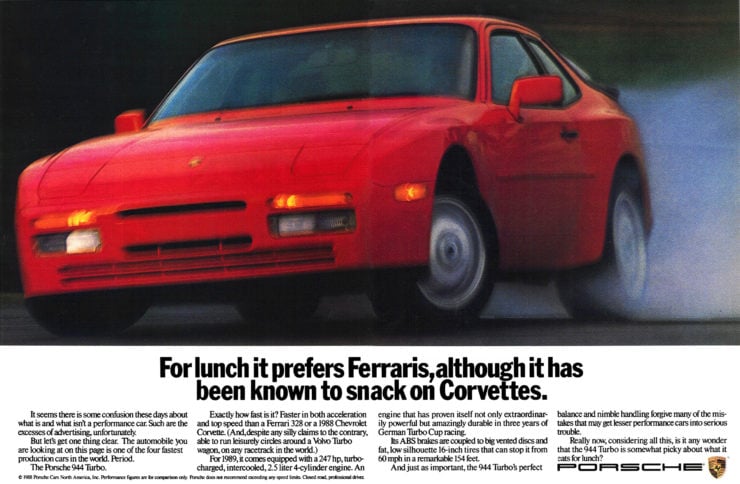
Le Mans of 1981 had been the ideal venue to debut the new Porsche 944. Its performance gave the new model “Le Mans racing car” credibility: and the presence of that high tech genuine Porsche engine under the hood of the Porsche 944 made it a much more desirable entry level Porsche. The engine was of course dramatically de-tuned for the road going production car but even so the new model Porsche 944 boasted a standing to 60mph time of less than 9 seconds, achieving 8.3 seconds on test.
The top speed was also rather impressive: Porsche only claimed the car would do 130 mph (210 km/hr) but on test it blew that away delivering 157.9 mph (254.1 km/hr), which was faster than the Jaguar E-Type production cars, and the 944 delivered that speed with superior handling in part due to the car’s 50.7:49.3 near perfect front to rear weight distribution achieved by the use of the rear mounted gearbox and differential transaxle. (The fact that the transaxle was made by Audi was of course not mentioned.)
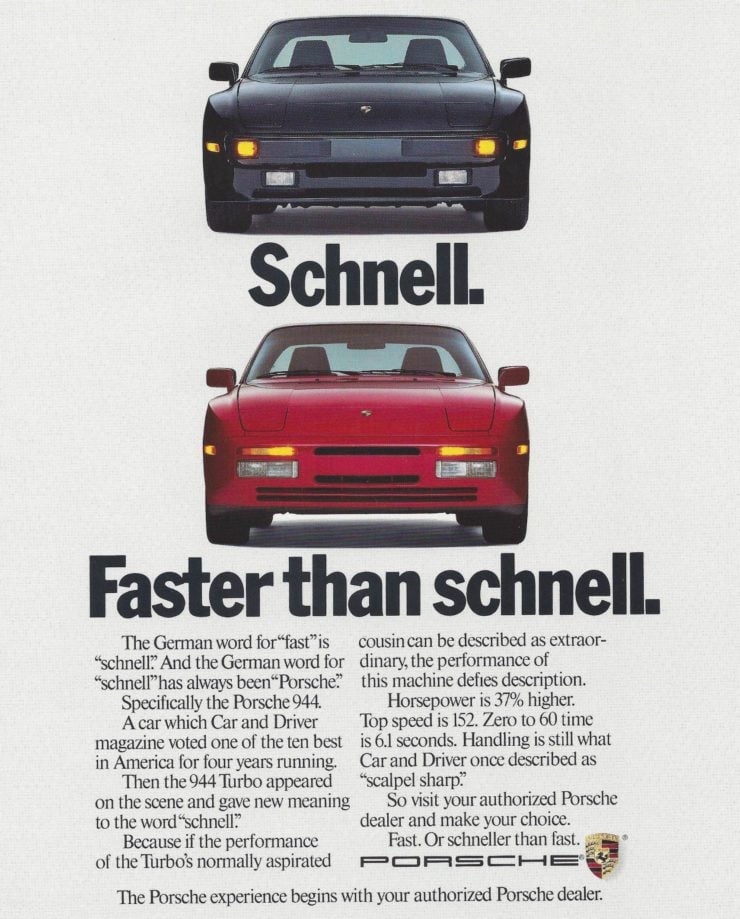
The first version of the 944 had the same interior as its parent 924 but with the flared fenders and genuine Porsche engine providing the Dr. Jekyll/Mr. Hyde distinction. By the middle of 1985 Porsche had decided that there was not enough distinction between the two models and so they gave the 944 a new dashboard and door trims, along with an embedded radio antenna.
As an option powered seats with heating were available for Mr. Hyde’s who like their creature comforts along with a Hi-Fi sound system so one could enjoy Richard Wagner’s “Flight of the Valkyries” in glorious adrenaline pumping stereo: and to ensure one’s listening would not be marred by road noise the transaxle mounting was improved, so Wagner blended with the growl of the engine bringing out the full glory of both.
Under the hood the electrics were upgraded with the move to a 115amp alternator instead of the original 90amp one and the fuel tank was increased in capacity as was the engine sump. The wheels of the 944 were changed from the “cookie cutter” style to a telephone “swinging dial” style with Fuchs wheels available as an option. The suspension that kept those bouncing wheels attached to the car was also upgraded front and rear to new cast alloy control arms and semi-trailing arms.
1987 saw the fitting of an ABS (Anti-lock Braking System) which some purists would likely not have enjoyed, but which did add a measure of improvement in actual braking efficiency. The downside of the ABS was that Fuchs wheels could no longer be fitted because of the necessary 52mm change to the wheel offset.
he other potential purist eyebrow furrowing feature was the fitting of airbags, which provided additional safety, but which could not help but make the steering wheel a thing of ugliness in the eyes of those who appreciate the beauty of a traditional aluminum steering wheel. The engine of the 1987 model was equipped with an updated Motronic engine management system.
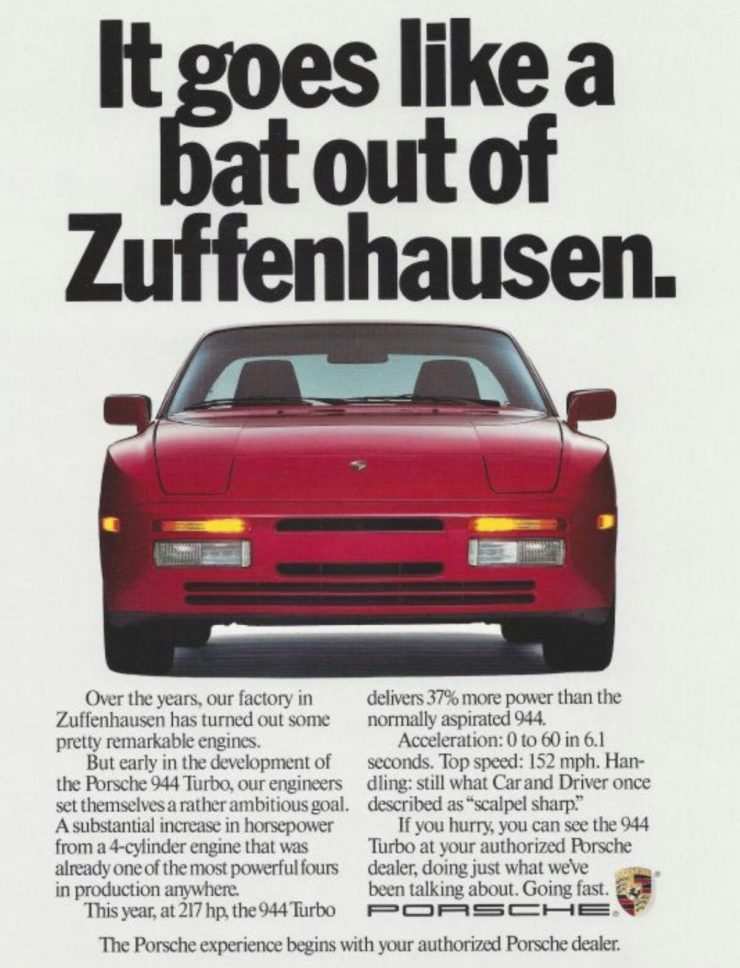
In the early part of 1989 the 944’s engine capacity was increased from 2.5 liters to 2.7 liters, the increase being achieved by giving the engine a bore of 104mm and stroke of 78.9mm. This increase prompted Porsche’s engineers to use a “Siamese-cylinder” arrangement, so called because the cylinders are all joined together with no coolant passing between them.
This engine also required a new cylinder head design with larger valves. The engine produced 163hp, exactly the same as that for the original European market 2.5 liter engine, but was an improvement for US customers.
The Porsche 944 Turbo, Turbo S, and Turbo Cabriolet (1985-1991)
It didn’t take Porsche’s engineers long to significantly improve on the base 944’s performance by doing the obvious and adding a turbocharger to the engine. The 944 Turbo entered production in 1985 for the 1986 production year and it made a significant difference to the stock 944’s performance. Power of the new turbocharged engine was 220hp and torque was 243lb/ft, a significant increase over the naturally aspirated standard 944.
This resulted in the car’s standing to 60mph time being reduced to 5.9 seconds, about a 3 second improvement. Significant engineering went into this performance increase with the 944 being the first production car from Porsche to use a ceramic port liner and also the first to have the same power output regardless of whether or not a catalytic converter was used.
To help that hot little turbocharged four cylinder engine to keep its cool it was fitted with an oil cooler and the transmission was also treated to one. The transmission had a different final ratio and was made stronger to cope with the 217hp being channeled into it, and the suspension was given progressive springs and made slightly stiffer.
In order to stop this little road rocket new brakes were in order, the same 12″ discs as used on the prestigious 911 with Brembo four piston fixed calipers, ABS being provided on US market cars. These brakes were ensconced behind 16″ wheels, with Fuchs wheels available as an optional extra.
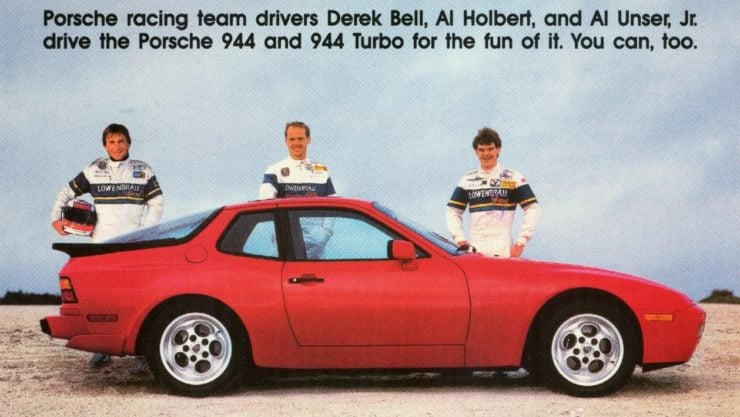
1987 the US model of the 944 Turbo became the first car in the world fitted with both driver and passenger air bags as standard equipment. For all regions the transmission cooler seems to have been regarded as unnecessary so it was removed while the speedometer was changed from a 170mph (270 km/hr) to a 180mph (290 km/hr) unit. The engine remained unchanged however so the car’s performance was kept the same, it was at that time fast enough. The steering was modified to reduce the scrub radius by changes to the suspension control arms.
In 1988 the “Mr. Hyde” types were treated to a new more powerful model: the 944 Turbo S (the “S” not standing for “Scary” but for “Super”, because this was a Porsche and so you would always feel in control). The engine power was upgraded to 247hp @ 6,000rpm combined with torque of 258lb/ft @ 4,000rpm by use of a larger KKK K26-8 turbocharger unit combined with revised engine mapping. This new mapping kept the turbocharger boost at 10.9psi up to 3,000rpm and then reduced it to 7.5psi at 5,800rpm, matching boost with fuel and ignition for optimum efficiency.
That engine delivered its power through a heavier duty clutch and transmission fitted with a cooler. The limited slip differential was given a 40% lock setting.
The 944 Turbo S had moderately improved performance with a standing to 60mph time of 5.5 seconds, it would do a standing quarter mile in 13.9 seconds finishing just over “the ton” at 101mph. Top speed was stated by Porsche to be 162mph (261km/hr). These performance figures made the Porsche 944 Turbo S the fastest four cylinder production car of that period.
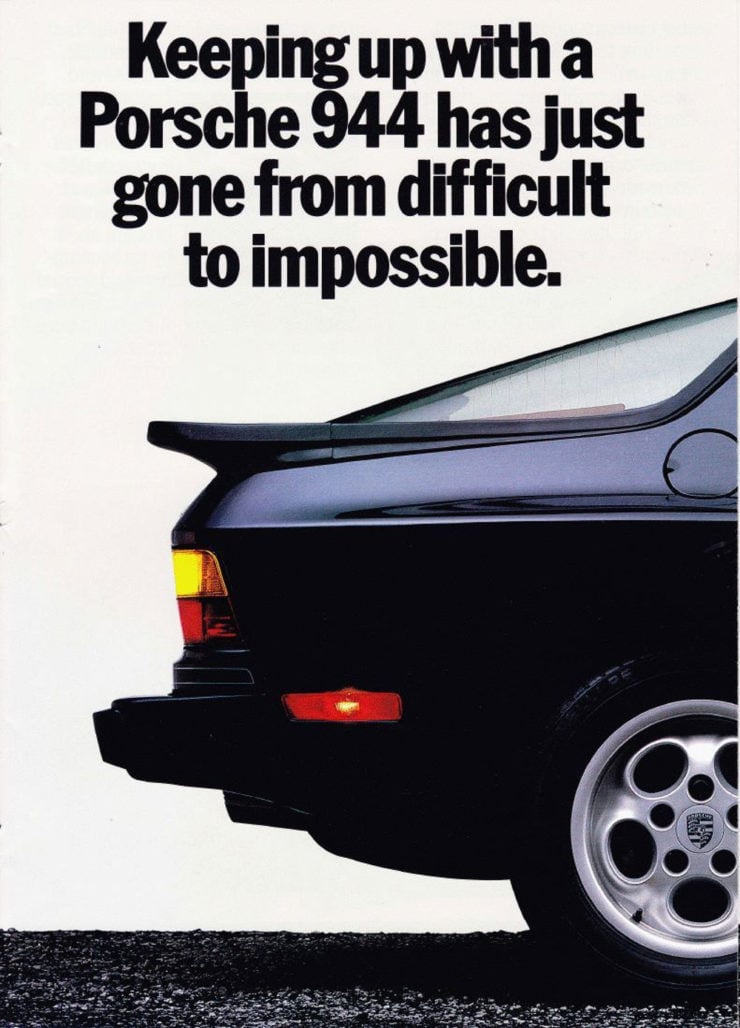
In keeping with its performance Porsche’s engineers fitted the car with the M030 suspension package as standard. This gave the car progressive rate springs, larger hollow anti-roll bars and Koni adjustable shock absorbers, with the front units being adjustable for ride height. The wheel design was called “Club Sport” and these were forged by Fuchs.
These wheels were of 16″ diameter with the front being 7″ wide and the rear 9″ wide, shod with 225/50 tires at the front and 245/45 at the rear. The car’s fenders were remodeled to suit the wider wheels and tires. Brakes were fitted with ABS and the front brakes were the same as those used on the high performance Porsche 928 S4 being 12″ diameter and fitted with Brembo four piston fixed calipers. at the rear the 944 retained the same 12″ brakes as used on the 944 Turbo.
The interior of the 944 Turbo S treated occupants to power seats and a 10 speaker sound system was a popular optional extra. Many cars were finished in a Burgundy Plaid exterior color scheme which seems to have been a common choice.
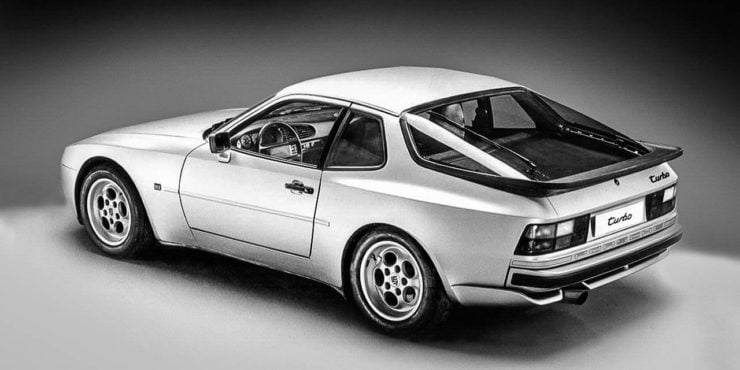
From 1989 until the end of production in 1991 the 944 Turbo S was dropped as a specific model and all the 944 Turbo cars were fitted with the Turbo S engine and transmission. Those wanting the full Turbo S had to choose the optional M030 suspension package and “Club Sport” wheels.
The last iteration of the 944 Turbo was the 944 Turbo Cabriolet which was the 944 Turbo Cabriolet. This was a 944 Turbo S with a special cabriolet body made by the American Sunroof Company (ASC) of Weinsberg, Germany, who also made the bodies for the 944 S2 Cabriolet. 625 of the 944 Turbo Cabriolet were made with 100 being built with right hand drive and the remaining 525 being left hand drive. This model was not imported into the United states despite the fact that it would no doubt have been popular with California customers.
Porsche 944 S (1987-1988)
In 1987 Porsche debuted the 944 S, the “S” standing for “Super”. This “Super” Porsche 944 was fitted with a more high performance version of the naturally aspirated four cylinder engine. This engine version had dual overhead camshafts to operate the four valves per cylinder and a revised Motronic 2 engine management system with dual knock sensors to best handle the 10.9:1 compression ratio. Power was a comfortably adequate 187hp. This engine featured an automatic adjusting timing belt tensioner to go with the new design camshaft drives, and a magnesium alloy valve cover.
Generally the 944 S was a high performance version of the stock 944 although it was fitted with the rear wheel brake circuit regulator as used in the 944 Turbo and the gear ratios were optimized for the high revving DOHC engine which had a 6,800rpm red line.
Performance of the 944 S lay between the standard 944 and the Turbo versions. Standing to 100km/hr (62mph) was accomplished in 6.5 seconds and the top speed was 144mph (232km/hr). This model was fitted with larger front and rear anti-roll bars and progressive springs, similar to those used on the 944 Turbo.
Optional extras included dual air bags and a limited slip differential, ABS braking, Fuchs wheels, and a “Club Sport” package.
Porsche 944 S2 and 944 S2 Cabriolet (1989-1991)
Introduced in 1989 the 944 S2 upped the performance of the 944 S providing a 3.0 liter version of the DOHC double valve four cylinder engine producing 208hp. To suit this new engine version the car’s transmission and gear ratios were revised to get the best performance and driver experience.
The car delivered a standing to 100km/hr (62mph) time of 6.8 seconds and a top speed of 150mph (240km/hr) for the manual transmission version. The model was offered with the familiar options of airbags, ABS brakes, a limited slip differential: while 16″ Series 90 cast alloy wheels were standard.
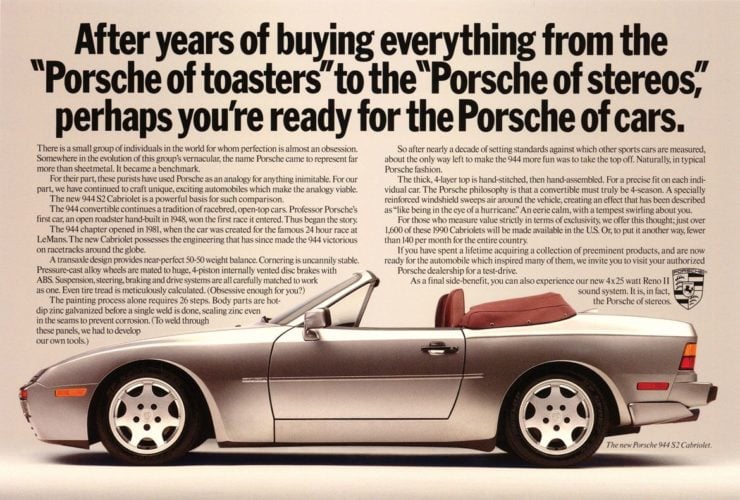
The 944 S2 Cabriolet was introduced the same year featuring a body made by the American Sunroof Company (ASC). While only 16 of this model were made in 1989 for the US market the following years of production saw no less than 3,938 for all markets.
Conclusion
During the final period of 944 production Porsche made the decision to phase the model out and replace it with another front engine car, the Porsche 968. By the time production ended Porsche had made and sold 163,192 944’s making it their best selling car to date.
The success of the 944 and its predecessor the 924 was not to prove sufficient to persuade Porsche to continue making front engine sports cars however. Despite them being a superb design and and sales success they were perhaps not really what people thought a “Porsche” should look like. It has been said that if the 924 and 944 had been made by someone else they would have been more readily accepted and I for one suspect that might just be true.
They were cars that broke the mould in terms of what people thought a “Porsche” should look like, and today many of Porsche’s best selling vehicles are front-engined, like the Porsche Cayenne, the Macan, and the Panamera.
So perhaps there’s more 944 (and 924) DNA still within Porsche than many people may think.
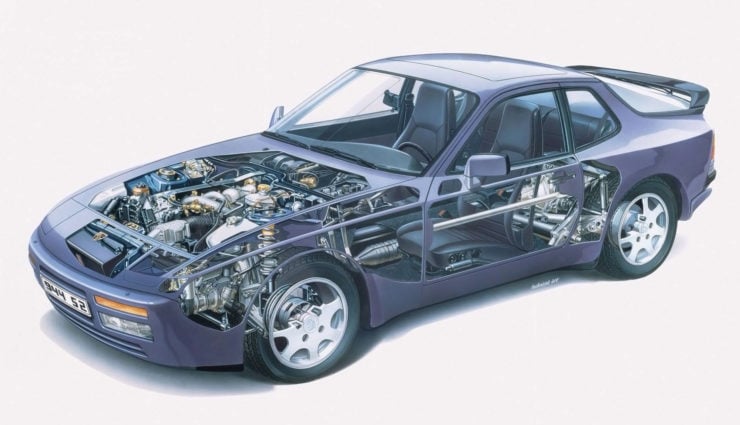
Photo Credits: Porsche AG.

Jon Branch has written countless official automobile Buying Guides for eBay Motors over the years, he’s also written for Hagerty, he’s a long time contributor to Silodrome and the official SSAA Magazine, and he’s the founder and senior editor of Revivaler.
Jon has done radio, television, magazine, and newspaper interviews on various issues, and has traveled extensively, having lived in Britain, Australia, China, and Hong Kong. The fastest thing he’s ever driven was a Bolwell Nagari, the slowest was a Caterpillar D9, and the most challenging was a 1950’s MAN semi-trailer with unexpected brake failure.


